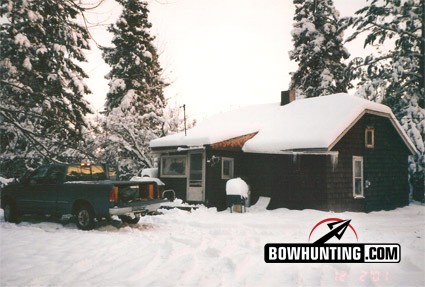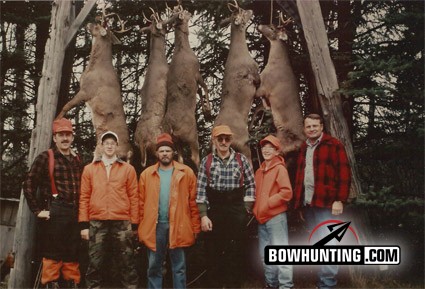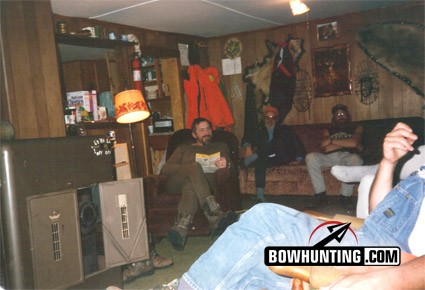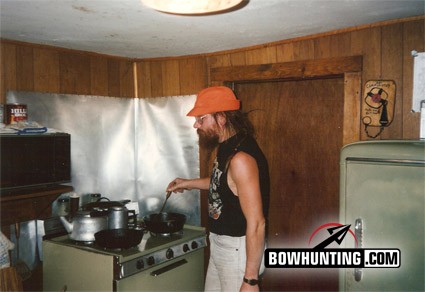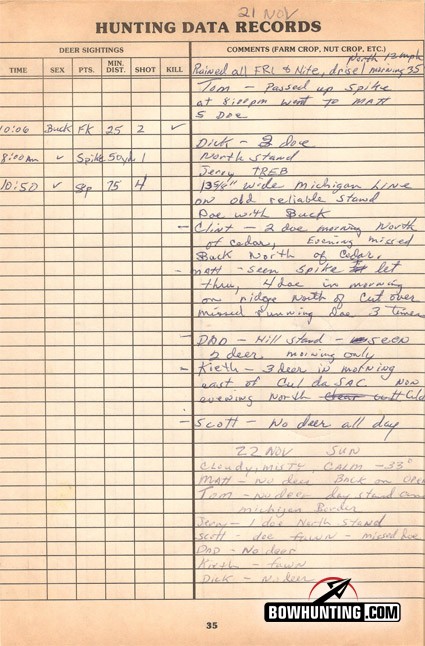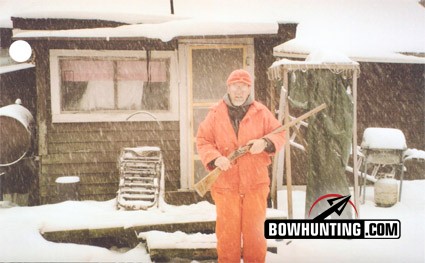LAST UPDATED: May 8th, 2015
If you travel to the far northern reaches of Wisconsin, less than a mile from the Michigan border, you will find a Little Brown Cabin nestled into the heart of the Nicolet National Forest. At first glance there is nothing special about this leaning cabin. In fact, most people would not even give this little dilapidated shack a second look. But if walls could talk, this Little Brown Cabin could tell one heck of a story. It would entertain you and teach you about history, share stories and memories that have been made with the help from this cabin. Yes, the tough northern Wisconsin winters have taken its toll on the body of this shack; it is weak and frail, uncertain of how many more years it may have left. But like an old man that has weathered through the test of time, it may be weak, but has much to say.
The Little Brown Cabin.
First to understand the stories from this cabin, you must understand the cabin first. The Little Brown Cabin was purchased by my grandfather in the late 1970’s for $3,500. What was a lot of money back then wouldn’t even get you an acre of land today. This little cabin sits on three acres of land surrounded by National Forest. With just three rooms, two full size beds and a bunk bed, there’s not much room to stretch your feet. It has no running water, no phone, no TV and is heated by an old oil stove. With no running water you can guess what the plumbing is. Gravity! Yes, it’s a comfortable “one-holer”, sure to have old faded hunting magazines to read while you wait. Behind the cabin is the famous Wisconsin deer camp meat pole. Oh yes, the meat pole, designed to hang your deer, to keep it off the ground and keep the critters off your prize meat and allow your deer to age prior to being processed.
Sure, she is not much to look at, heck it’s even been said that you will not find a flat spot, level board, or a square corner throughout the whole place. Mouse poison and mouse droppings are both a common sight on your visit to the Little Brown Cabin. The droppings make me question the effectiveness of the poison, but the poison states that it is known to cause cancer in the state of California! I guess the box didn’t state how long it takes to kill mice.
The Little Brown Cabin yearly group photo.
In the state of Wisconsin, tailgating on the frozen tundra at Lambeau Field during the fall is a sacred tradition, one that is only trumped by one thing: deer hunting. For nine days out of the year hunters flock to their deer camp like geese flying south for the winter. Hunters of all shapes and forms, young and old all head to deer camp. The camp at the Little Brown Cabin is no exception. For over thirty years a select group of hunters have been traveling each year to engage in the state’s favorite past time.
It all started with my grandfather, my dad, two close family friends Keith and Jerald, and several other friends of my dad. It was organized like a small military unit. The main officer that ran the camp was my grandfather. He was given the honorable title of “Head Buck”. He was the oldest, wisest, and had the most experience. Younger hunters looked up to his leadership and advice. Second in command was my father, followed up by friends Keith and Jerald. At this camp the only thing seniority played a part in was hunting advice and storytelling. All members of the Little Brown Cabin camp pitched in with the camp chores. The best cooks in camp took care of the meals, and the cleanest members did the dishes and kept the camp tidy. Everyone had a place in this camp. As years went by, my two brothers became old enough to hunt and began a new age in deer camp. It wasn’t long and I became a part in the Little Brown Cabin camp as well.
My dad, “Head Buck”, filling out the camp log.
Tradition was the heart and soul of northern Wisconsin deer camp. Every Friday before opening day my father made our traditional meal of venison. For thirty years my father found thirty different ways to make venison. Like kings we all had our spot around the kitchen table. After supper we would turn on the old radio that was sitting on top of the refrigerator and listen to the “Deer Hunter’s Round- Up,” a local radio station that would broadcast statistics and stories of successful hunters from both Upper Michigan and Wisconsin. While listing to the radio we would look over old worn and torn topography maps and aerial photos of our stands for the next morning’s hunt. After getting our hunting gear all set for the next morning we would sit around the “Head Buck” and listen to his stories of past hunts. Grandpa’s storytelling methods were unlike any other as he always had everyone’s attention. To this day, I can picture the stories as they played out in my head as he was telling them. Soon after dark we would all head to bed because morning would come early in deer camp.
Jerry making breakfast for the camp.
Camp enjoying breakfast before the hunt.
The next morning after a “gut busting” breakfast, we would head out to our stands like a Civil War battalion. The most exciting part of the days hunt was not being in the tree stand waiting, but the walk back to the cabin to see if anyone had any luck for the day. As I would walk back to camp I would peek around the cabin to look at the meat pole like a child peeking out of their room on Christmas morning. If we saw deer hanging we would hurry up to the successful hunter and congratulate them. While admiring their deer we would all stand around and listen to the story of the hunt. You could hear the excitement in every word as the hunter would recap the hunt. After everyone had their chance to tell their own stories of the days adventures we would head
One of many camp logs recapping the days hunt.
into the Little Brown Cabin for supper. After supper with the “Deer Hunter’s Round-Up” playing, my father would sit in his recliner next to the desk of memories. As he would sit there he would interview each hunter and log their deer sightings for the day. We called his desk “The Desk of Memories” because it contained all of the photo albums from the history of the Little Brown Cabin, and in each album was logs written down for thirty years of the hunter’s stories from the past.
This is what the tradition of deer hunting is all about, memories, friends and families. The Little Brown Cabin is what started it all for our deer camp. For over thirty years this little shack has heard every hunter’s story. It has seen success, it has seen good times and great friends. As the years have gone by we have changed. We have gotten older; my grandfather is no longer able to make the yearly journey north to the cabin, my father is now the “Head Buck,” and our camp has gotten smaller. Just our two close family friends, Jerald and Keith, and my family make their way north each year. Yes, things have changed. Some may blame the lack of deer numbers in the north, or the tough hunting in the big woods of the National Forest. However, life is always changing and life is about adapting to change. But one thing hasn’t changed; the little shack looks today exactly like it did years ago. The memories are made each year just like they were in the past. For as long as there is a “Head buck” there will always be deer camp in the north woods.
Dan hunting with primitive black powder in Wisconsin’s north woods.
My mother has been pressuring my dad to build a new cabin, one that is up to date with running water. This all began about nine years ago. My father never started any work on this new dream cabin. When the “Head Buck” was asked why, he always stated that he just didn’t have any time. He always said that he would start working on it when he retired. Since then, he has retired and it has been almost ten years since the start of my mother’s dream, and if you drive by you will see the Little Brown Cabin sitting there like a wise, elderly man worn through time sitting on a park bench. No trees have been cut, no lines surveyed. The “Head Buck” may not want to admit it because of fear from the “Head Doe,” but he too understands that the Little Brown Cabin has seen over thirty years of great memories, and she is just as much of the Wisconsin deer hunting tradition as the deer themselves.
The next time you are driving around and see an old worn out shack, think to yourself about the stories that those walls could tell, the memories made in that little shack and what hunting life was like in the years past. We have all seen or even been a part of our own little brown shacks, and without the traditions, friends, and family, we will lose our history and we will lose what we as hunters are all about. We don’t hunt for the kill; we hunt for the memories, friends and good times in the great outdoors. We as hunters all have a little brown shack within us, because if the walls could talk they would tell one heck of a story.

